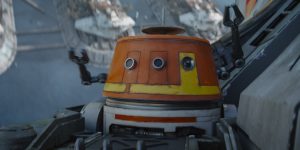
Trending Today
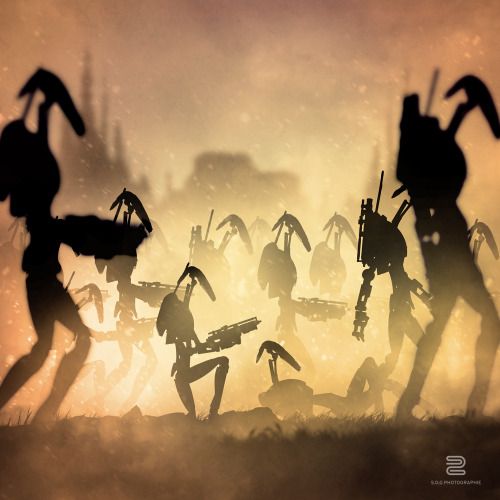
Hey Troopers! Welcome to our unit guide for the B1 Battle Droid for Star Wars: Legion. This guide will cover the B1 Battle Droid unit, as well as their myriad upgrade options.
Original article by Kyle “Orkimedes” Dornbos with Legion 2.6 updates by Evan “Doc Velo” Paul.

Cost: 38 points. It really doesn’t get much better than this.
Defense: 1 wound per model, white save, no surge. This is literally as bad as it gets. They start with six models though, which is more than any other unit except Ewoks and, weirdly, Rebel Sleeper Cells. And if you give them surge tokens they become as durable as a Rebel Trooper unit (not exactly a crowning achievement) but with 50% more raw wounds.
Offense: White dice, no surge. Also literally as bad as it gets, but you are still throwing six dice.
Courage 1, Droid Trooper: The courage is standard fare for a corps unit, but droid trooper is a fantastic keyword. They don’t gain cover from suppression, but they also don’t lose actions to it. Make sure you keep them close to your commander because they can still panic.
AI: Attack: This keyword can be absolutely devastating when it triggers in certain situations. You can usually prevent it from triggering by by making sure your B1s have face-up orders all the time, but that itself can be fairly restrictive on the positioning of your corps. waiting for the rules to change in such a way that the burden of AI is pretty minimal. Jokes aside, you now will only default to AI if you are on the battlefield (no turn 1 AI for you!), don’t have a face-up, AND are Range 4 or beyond from a Commander. How often are B1’s in such a situation? Not much.
Coordinate: Droid Trooper. While it’s less necessary from the standpoint of limiting AI, the ability to maximize the number of face-up orders is still incredibly good. Note that all game effects except attacks are measured from mini to mini, not from unit leader to unit leader, so you can spread your squads out via cohesion to extend their coordinate range.
Heavy, Personnel, Comms slot: They don’t have many slots, but each of these has a variety of choices. B1s and B2s are the only corps units that have a comms slot printed on their unit card. B1s can also take electrobinoculars or portable scanners even though they don’t have a gear slot.
Running an order chain through multiple (usually, all of) your B1 units carries multiple advantages aside from guarding against the ever-rarer instance where AI will actually trigger. It’s most important for improving order control, but can also help get surge tokens on your units if you are running Aggressive Tactics on your commander.
This can be enabled by a few ways. First, you can order them with a command card. Next, there is the Direct keyword which is shared by many of the Commanders CIS has access to. Lastly there is this thing:
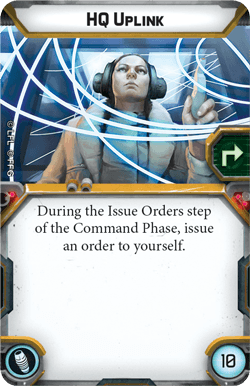
Which used to be a lot more common in the past but can still be seen now. Whatever way you get the order, you only need that first one to “start the chain.” Then you can keep it going until the very last B1, who will hopefully have some kind of non-B1 droid trooper to pass it along to in order to really squeeze all you can out of that order control.
Your B1s need to be able to coordinate to each other, and to do that they need to be close to each other. Since coordinate is measured from mini to mini, I like to do what I call “honeycombing,” which basically means that you overlap your B1s such that each B1 is within range in both directions of multiple other B1s, so if you lose one unit it doesn’t break your chain.
Additionally, your uplink unit (if using one) needs to be in a position where they can bounce an order to kick off an entire chain, which generally means they need to be on the ends of your chain.
This is an example of honey combing:
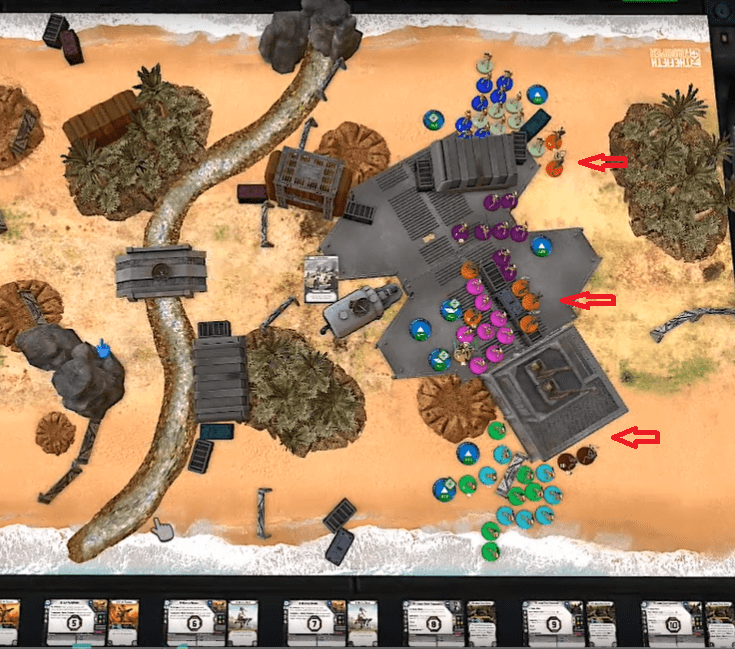
The light blue and dark blue B1 units on either end of the chain are the uplink units; the red arrows point to the BX droids (orange, burnt orange, and brown). Note how all the B1 units are overlapping, so they have more range to bounce orders and if one of them gets iced it doesn’t mess up your chain.
I put my uplink units at both ends of the chain, so that I can 1) start the chain from the end and bounce in both directions, and 2) bounce directly from an uplink unit to a BX unit if the chain starts on the opposite end. For the latter reason, I usually put my BX strikes at the end(s) of my chain. If you keep this tight it shouldn’t be an issue to get perfect order control every turn.
In general, understanding the cohesion rules is really important for positioning your B1 models. Your B1 units are going to have six to eight models in them, which means 1) you need more minis in cover than other corps units to gain the benefits of it, and 2) you are going to be taking up more board space than other armies, which means you have to make more efficient use of the cover you have available. Check out this article on Cohesion for some key tips on how best to position individual models in a unit.
B1s are individually pretty bad. A single unit of six or seven B1 models can be focused down rather quickly and is unlikely to be able to do much more than plink away at a few targets.
You know what isn’t bad? 40 B1s. Suddenly you have a lot of bodies and dice for your opponent to deal with. Coordinate isn’t the only reason to keep your B1s close to each other, you need to make sure they are supporting each other offensively.
B1s have one very important weakness when it comes to gunfights, which is that their effective engagement range is 3. Even though they can equip a Range 4 weapon (the E-5s) its output when it is in a pool by itself is pretty dismal. Other factions have much better access to range 4 firepower with their corps units. This means you need to be extremely careful about how and when you get your B1s involved.
CIS has two very strong area control pieces in Dooku and Grievous, and two great long-range firepower pieces in the AAT or Snail Tank. I like to be cagey with my B1s until my opponent has their hands full with one of those anchor units. Threat saturation is important for any list, but it is doubly important for a faction like CIS where your corps units are so fragile and so individually weak.
And now the most interesting part. We’ll take a look at each of the heavy upgrades, in order of awesomeness.
Really though, they are all pretty decent.
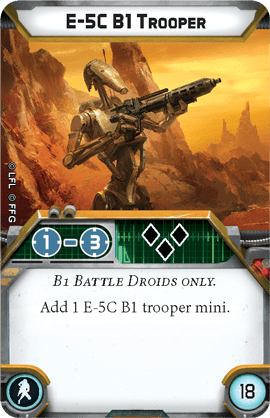
It’s an E-5, but bigger! I’m not sure what the “C” stands for. I’m going with Cato Neimoidia, after its place of invention. Would that pass muster in Balderdash?
Anyway, this thing is a bargain. It basically doubles the offense of your B1 unit for 16 points. The average hits on this thing clock in at exactly 3 when you combine it with the rest of the pool, which is basically the worst heavy pool of any corps unit that isn’t naked (DLT-19 is 3.25, Z-6 is 3.5, DLT-20a is 3.86, for comparison). It’s also the cheapest one though (by a lot), at only 54 points, so it is kind of hard to complain about. B1s also shed white dice when they take casualties instead of black dice, which means this bad boy is heavily backloaded.
What gets really interesting is when you give them surge tokens. A single surge tokens increases their average hits to about 3.7, which is rather punchy for a 54 point unit.
The E-5C is my default heavy weapon choice when I am kitting out my B1s.
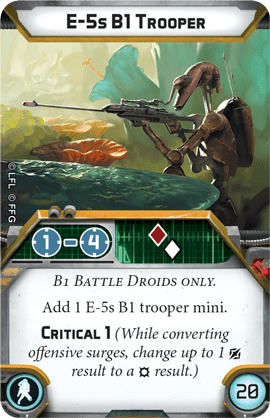
The longer, pointier, cooler looking cousin of the E-5C. I’m not really sure why the “s” is lowercase, or why this dude needs a wire to connect his face to the scope (how does he run like that?). Anyway, this is my second favorite heavy weapon choice for B1s, and I often end up running 1-2 of them.
Why not 6? On paper, this thing looks objectively better than the E-5C.
This thing does an average of 3.14 hits when you account for critical, which is a little better than the E-5C. However, the E-5C is better than the E-5s under the following circumstances:
Let’s not discount the E-5s entirely, though. There are a couple of situations when the E-5s is better:
None of these things are trivial. If they were the same cost, I would probably run a lot more E-5s, but two points isn’t nothing. Mostly you are paying for the ability to lay down suppression at range 4 and a minor armor hedge. Legion 2.6 is a closer game than it used to be however so the whole concept of sniping your opponent at Range 4 for half the game is such a thing of the past that this weapon has less going for it than it used to.

All good things must come to an end? This weapon used to exhaust and wasn’t cumbersome, now it’s the exact same as the Clone RPS but on a weaker chassis and without token sharing. Unfortunately, this is going to be a poor choice most of the time.
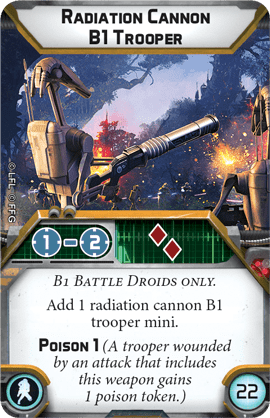
The T-Shirt cannon! Well, it shoots irradiated T-shirts.
Anyway, this thing hurts. It does the same average damage as the E-5C when combined with the full unit (3 hits) but it tacks on a poison token when you do a wound, which is free, unavoidable damage. Units with good saves and/or pierce immune really hate poison tokens. I’m looking at you, Jedi, Sith, and Mandos.
Range 2 and cost are literally the only drawbacks here, because the Radiation Cannon hits like a truck. A radioactive truck loaded with poison tokens.
Range 2 is a pretty significant drawback, though. This is an assault weapon, and B1s are decidedly not an assault unit. If you want a linebacker unit and you can’t afford B2s though, you could do a lot worse. You are going to be pretty happy if you ever manage to clap a Jedi or Mando with poison tokens from this bad boy. What’s more, running the “double sized” B1 squad makes it more likely to get the wound you need to add that oh-so-fun poison token if you want to get a little funky with your list-building.
Alright, let’s talk about naked B1s. Legion is a game about activations, and you can’t really do any better than a six-wound activation for 38 points. They hit like a wet noodle, but it is kind of hard to go wrong for that price. There are solid CIS builds that emphasize the other strong elements of the faction (AATs, characters, STAPs) while taking several naked B1s (sometimes with Medical or Repair bots) to score objectives and be a nuisance. Does your opponent really want to bother shooting a 36-point unit in heavy cover with six wounds when they have two tanks in their face? Make sure you still take at least one uplink unless you have another consistent source of orders.
Naked B1s aren’t exactly useless on offense, either. Basically, you are crit fishing, but six dice have a 55% chance to roll at least one crit. You are flipping a coin to push a crit through.
We’ll start with the really fun one…

From what I can tell these were costed based on the quality of the attack dice they add, which I suppose is why the Rebel Vet squad upgrade is 15 points more than the base cost while this one is the exact same. Anyway, if you run this and a heavy you end up with a single unit that has 14 minis and wounds! That said, the B1’s gain the least from the addition of the Indomitable that these upgrades give since they’re uh…droids. More importantly, players should ask themselves what they’re actually getting out of this. If you get another unit instead you get one less health and white dice out of it but you DO get another unit that can score objectives. I’d say this is a more interesting choice than it usually is with these big-squad upgrades, but that’s mainly because the cost is the same as the squad cost. The other argument is the Radiation cannon, since big dice pools are more likely to worse that required wound through.
Some of y’all are gonna be tempted to glue 112 B1 heads together in order to spend 736 points on 8 Rad Cannon doubled-sized units in the Separatist Invasion Battle Force, and all I can say to you is…you’re wonderful, but also, you’re crazy.


A B1 and either one of these heal-bots is the cheapest way to get either type of healing in the entire game. so it’s no surprise that both are common sights in CIS armies.

This is an under-considered upgrade in my opinion. Though the loss of AI means little now, a B1 with the T-Series and an E-5C throws 3.74 hits on average if the surge is available to spend. That unit can then take six wounds, losing everything except the leader (which will be this mini) and the heavy and still deal 2.2 hits on average. For a little context, for 72 points that unit has about the same offensive efficiency as a Clone Z-6 assuming said clone unit also has access to one surge token. While these guys are gonna end up suffering a lot fewer wounds than clones, they will take those hits with more grace. Despite all this, I would only consider one or two of these if you have the extra points to make a couple squads especially potent at range.

At 6 points this is the budget choice for rounding out Rad Cannon squads since you’ll be closing to Range 2 anyway. When you have the time to take this action, observe tokens are better than aims since they allow you to re-roll your red dice and then leave the rest for your other shooters.
I’ll finish by mentioning here that there are two Personnel upgrades that come in the B1 Upgrade Pack, the OOM and the Security Droid. We should take a moment to applaud these two for being, unequivocally, the least helpful miniatures in the game. Coordinating at Range 2 has never enabled a list to be good and AI rarely happens anymore. They’re hopefully both going to be targets for the anticipated card updates in August 2025 but that’s dependent on AMG remembering they exist. I’d forgive them if they didn’t, I’ve never once seen them played in a list and you probably haven’t either.
We already talked about HQ Uplink above. Mostly I leave the comms slot naked on my non-uplink B1s, but there is another interesting possibility.
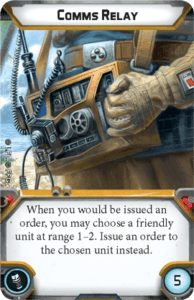
Comms relay does two things when you put it on a B1 unit: it lets you transfer the order they receive to any unit type (rather than coordinating to a droid trooper) and it lets you do it at range 2 instead of range 1. Importantly, however, it only transfers the order, it doesn’t duplicate it like Coordinate would, so your B1 doesn’t end up with a face up order. Nonetheless, this is useful if you want to bounce your chain to a vehicle like STAPs (who can then continue the chain to more STAPs or even more B1s) or an AAT. This can be a useful combination with a Commander that has Direct, which allows you to both lengthen the Range of the Direct effect and allows you to put that order on whatever you want.
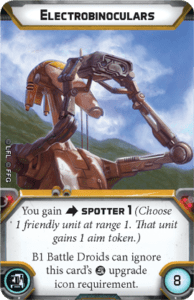
There is a B1 on this card, and I really want to like it.
This takes an action though. All you are really doing is transferring an action from your B1 to the target unit. I could see taking one of these on a naked B1 to pass aims to a BX sniper, but even then, 8 points is a lot. I can think of a lot better ways to spend 8 points.

The scanner has a bit more of an argument because you can use it to dodge-up Grievous to enable “Block.” Dooku used to like it too but now you don’t need dodges for Deflect so it’s not as crucial.
So how many B1s do you want to take?
B1s are the utility units of the CIS list. Sometimes you are going to give them heavy weapons, sometimes you are going to run them naked. In most lists, there will be at least a couple since they are so much cheaper than B2’s are. In the Experimental Droids Battle Force, it’s almost always two since this both provides the above-mentioned utility and prevents you from needing to consider the generally woefull Magna corps units to meet your requirements.
CIS is probably the most internally well-balanced faction, which basically means they have the most viable list variety of any faction. Do you want to run Dooku? Grievous? Maybe take some STAPs? Double tank? Single tank? BX droids with swords? Snipers? Mines? Some combination of the above? All of these are perfectly excellent things to run alongside your B1s.
Hey, look, a hobby section! What can I say, I enjoyed assembling and painting my B1s. I’m not sure if that makes me some kind of masochist.
You can find lots of great hobby supplies in our store, including paints, paint brushes, basing materials, and more.
B1s represent the first step into a brave new world for the Legion hobby: hard plastic sprues. B1s are spindly and skinny, and there really isn’t a way to do them in PVC. That’s fine though, because hard plastic is awesome. It’s durable, it’s detailed, you don’t have to boil any water to fix bent bits, and it is easy to customize.
I really dig how posable the B1 kits are. I come from a long history of playing Warhammer 40k, and when I first got into Legion the mono-pose nature of the core set models was really off-putting to me. Now you can have 50 droids and they can all be posed a little differently.
That said, the assembly difficulty is definitely something of a step up from the mono-pose PVC models. Customization comes with a price. The difficulty still pales in comparison to most GW kits, but if you aren’t used to sprues it can certainly be a challenge.
First, check out our very own Dustin Harvey’s video on assembling B1s.
A couple of my tips for assembling your B1s:
I have also seen some folks clip out all the bits beforehand and use egg cartons to organize all the parts together before assembling them. I prefer to put my Roger Rogers together one at a time but I could see that working rather well.
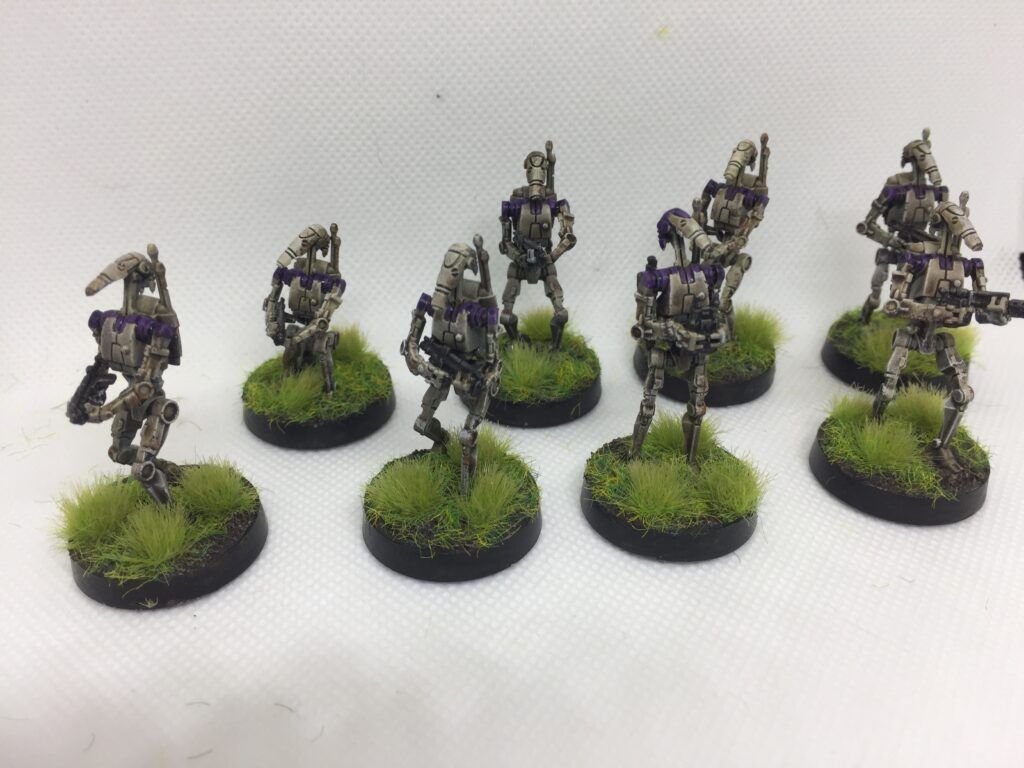
My quick and dirty Roger Rogers
There are a ton of different ways to paint your B1s. Colors aside, B1s have a lot of hard edges and crevices, which means they lends themselves to quick painting techniques such as dry brushing, washes, and GW contrast paints. This is fortunate, because you need to paint 40+ of them. They can look really good with relatively minimal effort, though.
For my part, I went with the “standard” Naboo style tan colors. Beige is an easy color to paint and is fairly forgiving of mistakes. I knew I was going to have to paint nearly 50 of these dudes so I wanted to strike a good balance between difficulty and art.
I have an airbrush, which I used for many of these initial steps, but you could easily do most of this the old fashioned way.
This was my process;
Like my overall painting job, I wanted the basing scheme to be relatively easy and repeatable. I really like the GW technical paints for jobs like this; you can slap them on and they look solid without having to do anything else.
I took it a couple of steps further though to get my dirt/grass effect.
Before we go, let’s talk about one more critically important hobby topic…
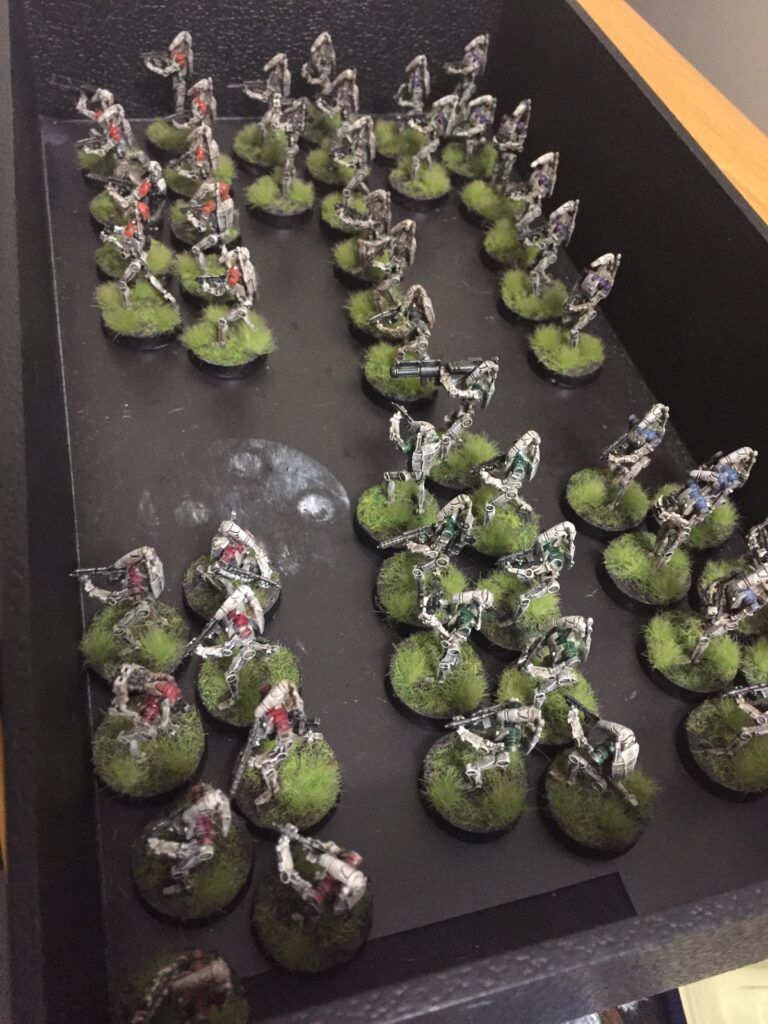
Squad markings are kind of a hot topic. Personally, I find them absolutely essential; both for my opponent and for myself. B1s tend to get mixed up a lot, and it is really important to be able to tell on a model by model basis which mini belongs to which unit, from three feet away.
I went with different colors for each unit across the shoulders, because it is easy to see and meshes with some canon paint jobs of B1s. I also like to be able to refer to units by colors, it makes communication easier and speeds up play (i.e., blue B1 is going to attack yellow clone). I have seen a lot of different ideas for how to accomplish this; some people put markings on their bases or paint the base rims different colors. I have seen some really creative ones where folks integrate the different colors into the scheme of their models, or use different colored foliage on their bases (Felucia provides a unique opportunity for something like this). These ones below are some of my favorite, from Trezkapepsi on the discord:
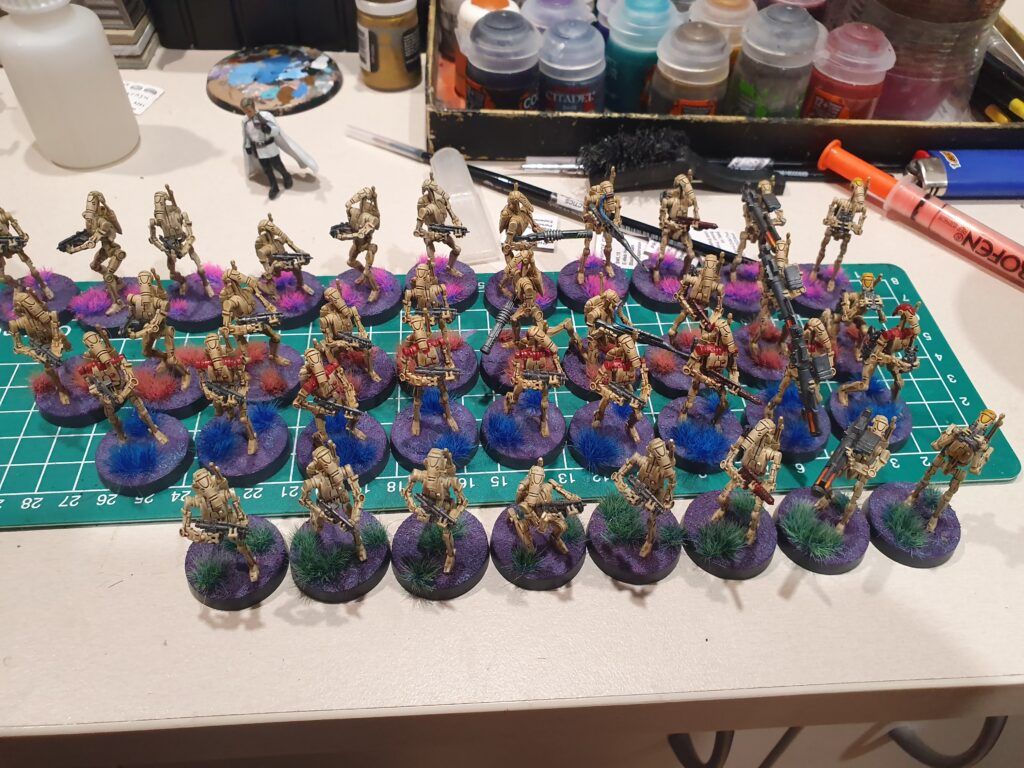
Make sure you have a plan for how to do squad markings on your B1s, or both you and your opponent are going to be pulling your hair out and wasting a lot of time trying to figure out who belongs where.
I hope you enjoyed this B1 unit guide! Check out some of our other great articles on the blog.


Copyright © 2024 The Fifth Trooper. All Rights Reserved.